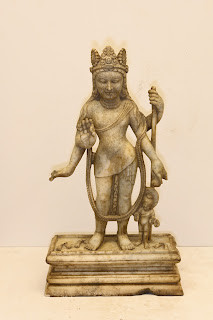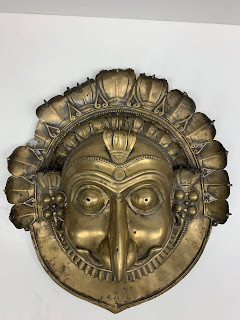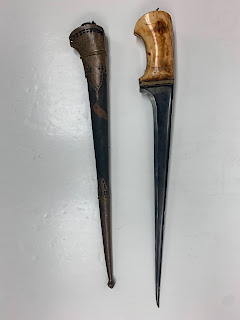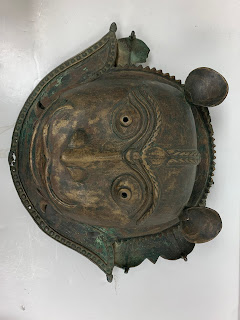 |
| Assistant District Attorney Matthew Bogdonos and four of the ATU's analysts |
Trigger Warning: This is probably going to be the longest article ever written on ARCA's Art Crime blog.
Stolen cultural objects should be returned to their owners.
This concept seems straightforwardly simple, and certainly isn't novel. The duty to prosecute criminals and return stolen property, obtained in violation of the law, goes far back in time. In some cases, even farther back in history than the very artefacts we passionately advocate for the restitution of.
The concept of punishments for thieves was already written into law...in the 20th century BCE.
Get caught stealing in broad daylight? The penalty for the offender was pecuniary (5 siqlu of silver) and one hopes at least a few scathing looks from members of the community. But stealing something under the cloak of darkness or the selling of stolen goods was considered a serious crime (grand larceny) and this level of wrongdoing could cost the pilferer his, or her, life.
Nowadays, in the United States and in most of Europe, individuals convicted of cultural property thievery receive only "daylight" sentences. Regularly, they amount to probation, or probation with fines of varying sizes.
Regularly, the criminal handlers that are formally charged for dealing in purloined antiquities, plead out, and never face a jury of their peers. Instead, their courtroom presentations before judges follow closely on years-long discussions, between defence counsel and prosecutor, where both sides hammer out cooperation agreements whereby the indicted individual coughs up sufficient intelligence to convince the prosecutor to make a recommendation to the judge for a lighter sentence when the value of their cooperation is considered “substantial.”
Instead, their guilty plea confessions are well-scripted lines in a passion play, crafted by counsel and designed to relay to the judge that the indicted individual is admitting their guilt voluntarily. In making their plea, the defendant has consulted with their attorney and acknowledges that they willingly give up important constitutional rights, including their right to a trial by jury, the right to testify or not testify, and the privilege against self-incrimination (meaning the right to not reveal information about criminal acts that they may have committed).
In “accepting responsibility” for their actions these formerly upstanding members of the art market, are banking on leniency, based on earlier assistance agreements, while acknowledging that they are prepared to accept the recommendation of the prosecutor (or in Federal cases the judge) as to the sentence or other disposition of the case.
The formulaic style of ARCA's restitution articles (which hold true for the majority of newspapers as well).
Usually, when stolen or plundered cultural property returns home, ARCA writes an article on said restitution in what can be seen as a fairly predictable format. One that repeats itself, more or less, regardless of where the object was stolen from, when or where it was recovered, and detailing its send-off back to whence it came.
In drafting our articles, we comfort ourselves that justice in the form of restitution, has, at least in some way, been served. Then we move on to creating a headline that specifies exactly what is going home and to whom.
We generally open our story with a photo of the object, or objects, and as best we can, move quickly on to giving credit to the prosecutor or prosecutors, law-enforcement agents, governmental officials, non-governmental organisations, legal experts, academic professionals, and citizen activists whose efforts were involved, naming those directly involved by name when we can and by the agency when for investigative reasons we can't.
We also take some time to thank the ministry workers, politicians, and law enforcement agencies who represent the receiving source country, as well as their own stakeholder institutions. These are the people who work on the other side of the seizure equation, and their involvement is often just as critical.
After thanking the "good guys" and adding a few photos of the pomp and circumstance which inevitably accompanies a handover ceremony, we move on to the artwork's storytelling, being sure not to interfere with any additional ongoing investigations, but hopefully illustrating why it's important for these historical objects to go home.
We then spend some time connecting the places the object originated from, when the artefact was likely uprooted from its find-spot, and as best we can, illustrating whose hands we have confirmed that the artefact has passed through. This story-weaving serves twofold. It helps, we hope, bring the artefact, and the people who made it, to life, and to perhaps illustrate the circuitous routes these pieces take as they are laundered over and over again to make them appear reasonably legitimate to buyers. In crafting this part of our article, we try where we can, to emphasise the loss to aggrieved societies, and to illustrate that in some cases these are not simply beautiful sculptures, but also sacred idols to some religious groups or grave goods from someone's grandfather's grandfather's grandfather's grandfather whose burial place shouldn't be plundered.
Lastly, we usually close our articles with a bit of scolding, a reminder if you will, to collectors and dealers about the necessity of conducting and not overlooking due diligence. We hope that in doing so, we as writers apply subtle pressure on art market actors to try and do better. We also hope that our articles leave a connect-the-dots trail of negative publicity breadcrumbs of who knowingly did what and during what time period, so that lessor-informed buyers and researchers might find these missives when googling some of the art market's problem children.
But on to the real point of this blog post...it takes a village, no really.
While restitution articles regularly lament the loss of moveable culture to the source country or society, and spend time focusing on the artefact's cultural significance, we don't often drill down into giving anything beyond cursory credit to the people who make recovery their life's work. If names get mentioned, it's because they are the ones handed out to journalists via formal press releases, and listed as the important actors and agencies involved. And it is this very naming, which does not necessarily weigh who did what or over how many hours, named or unnamed, that hardly ever gets expressed in the cultural diplomacy restitution equation.
Some of the people who work on antiquities trafficking evidence are underpaid, relative their talents, and some are not paid at all. Both work to sift through the "noise" of available data to find sufficient evidence which meets the threshold of the legal framework of the country where the suspect artwork or antiquity has been identified. Many of these dedicated folks are truly not in it for the glory of having their names up in lights, but because they have a deep and abiding belief that these artefacts can, and should, go home.
To emphasise this, I have chosen to focus the rest of this article on just one of these team players, whose job it is to sift through both the chaff and the grain of all the available information surrounding a suspect object. One of the people who assists in determining what constitutes direct or circumstantial evidence in proving a crime.
In doing so I want to emphasise that what these individuals accomplish is every bit as important, and in some cases more so, that just visualising a match between a looter photo and a matching object in circulation on the art market or in a museum or private collection. Identifications are absolutely critical and necessary, but they are just one single part of each investigation. And while such IDs are persuasive evidence, one would be remiss to think that the identification alone is sufficient when building a case for seizure and, one hopes, eventual restitution.
So, let's talk about just one of those people who deserves our thanks.
 |
| Apsara Iyer, Yale class of '16 onsite at Machu Picchu |
I met Apsara Iyer, for the first time in September 2012, at University College London's Archaeology and Economic Development conference. Back then, long before she joined the Manhattan DA's Antiquities Trafficking Unit, she was a surprisingly enthusiastic and well-informed freshman at Yale University working on her Bachelors, and already thinking more expansively about the right to culture than most undergrads her age.
As one of the conference's early career panelists, I was taken in by her enthusiasm for preservation, as well as her sincerity. I listened with interest, as she knowledgeably spoke of spending time the previous summer in the Andes Mountains, above the Urubamba River valley and the impact of archaeological tourism on the indigenous Machiguenga communities in Peru.
Over a coffee during a break in the conference, we talked about folklore and the ancient traditions Señor de Tetecaca, Ullantaytampu and Machu Pikchu in the Valle Sagrado de los Incas and I laughed when I learned that she had successfully managed, at just 17 years of age, to get interviews from people in one of the most biodiverse places in the world. Interviews which ultimately would shape the backbone of her presentation.
Admiring her chutzpah, I'd later learn that her interest in historic preservation extended even farther back. In high school Apsara had helped bury two time capsules on the grounds R.S. Peabody Museum of Archaeology, stuffing them with snippets from life in 2010, some whimsical and some bitter. Two selected "artefacts" that struck me particularly were the BP gift card which served as a bitter reminder of the devastation caused by the Deepwater Horizon spill. Equally poignant, were the two opposing news editorials on New York City's proposed Cordoba House, back then referred to by Islamophobes as the “Ground Zero Mosque.”
By her sophomore year at Yale, Ms. Iyer had already been bitten by the art market research bug, and I had to smile when she dropped me an email telling me that she was exploring the local valuations of heritage in Cusco, Peru, and Udaipur, India in comparison to auction data and that she planned to spend the following summer doing independent research on antiquities trafficking. Although we didn't stay in close touch, I wasn't surprised to learn that after her MPhil, she had joined Assistant District Attorney Matthew Bogdano's team as an Antiquities Trafficking Unit analyst.
And as glorious as that sounds, more often than not it isn't.
Forensic analysts at the Manhattan ATU work long hours and they have to be adept fact and hypothesis sifters. For every single artefact brought to the attention of their office as suspect, it's folks on the team like Ms. Ayer that ensure that an object's case file has sufficiently concretised evidence which can allow for its seizure under New York law. And the amount of time it takes to make that happen should not be underestimated. Sometimes though, when analysts dig deep enough, their labours pull together an enormous quantity of disparate threads and intel, helping the Manhattan office to identify other tainted pieces, and that's how complex, multinational, networks are eventually dismantled and that's why the DA's office is good at what they do.
Why do DANY press releases lead with numbers and price tags?
Because investigations like these cost money, full stop. It's important for prosecutorial offices, ministries, and law enforcement agencies to substantiate the fruits of their labour in terms of the number of objects returned, relative their value and demonstrating impact to communities. Those higher up in the accounting of who-spends-how-much-and-doing-what food chain want stats which can justify the person-hours allocated in pursuit of these investigations. Press announcements have neither the space for, or an interest in drilling down into how many hours, or how many hands, took part in the process to achieve said results.
With pressing deadlines to be the first to report on a seizure or a restitution, heritage journalists also neglect that effort, and hours consumed by researchers, both inside and outside of law enforcement agencies. Instead, we favour the stories of the objects themselves and the people they belong to, in our efforts to demonstrate that heritage crime is not as "victimless" as some would like one to assume. At best, and somewhat haphazardly, we make room in our articles for a cursory outline of the steadfast researchers who combed through evidence in order to help combat this type of criminal enterprise.
So, given that this week Manhattan District Attorney Alvin L. Bragg, Jr., has announced
the return of 307 (more) antiquities valued at nearly $4 million to the people of India I'd like to do a little speculative math. Bearing in mind that my calculations here are just my own working hypothesis, based upon the minimum amount of time I would estimate an antiquities analyst at the ATU may have put in when working on a single suspect object.
Let's assume, conservatively, Apsara Iyer, or any of the another of the New York District Attorney's Office's ATU analysts has worked the following hours on one of the objects listed in Alvin Bragg's recent press release on their office's restitutions to India.
1 day to coordinate identifications and communications with external experts;
2 days to track down and fact check all known provenance relating to when this piece appeared for the first time in circulation;
1/2 day to analyse the visual and or digital content/meta data of looter photos;
1/2 day to analyse written correspondence between the handlers related to this object;
4 days to sift through all the direct and circumstantial evidence on this piece and organise a case file;
2 days to confer with lead counsel to work out strategies and to answer any additional unanswered questions;
1 day to write up and document all credible evidence, applicable under New York law, which can be used to request seizure or towards bringing criminal charges.
Total = 10 days x 8 hours per day or 80 hours per object.
80 hours per object x 307 objects = 24,560 work hours
Effort estimations like this can never satisfactorily be conveyed in a one page press release celebrating the return of stolen property. Though they can, and should be thought about, discussed, conveyed and appreciated when digesting these grand success stories. As it is this proven time and effort expenditure, which is every bit as critical to these restitutions as having the legal instruments in place which are favourable in a specific jurisdiction.
So, while the formulaic nature of art restitution articles will hardly ever drill down to any level of who contributed what and over how many hours, this unspoken reality is still worth everyone being cognisant of. Obviously, we still need evidentiary photos which demonstrate an artefact it its plundered state, but we also need dedication and analyses if these pieces are to become the success stories we all want them to be.
I hope in the future, in reading ARCA's blog posts on who owns the past, instead of only focusing on the criminal actors, the opportunists, the bona fide owners and the higher ups that head the restitution teams, we also spend a bit more time acknowledging the work of the rank and file. Sure, they sometimes get their picture taken at that all important restitution ceremony, but it's important for us to remember that they often have a more personal relationship with the artefact that is going home than most of the folks shaking congratulatory hands and smiling.
To close, I'd like you to look at just some of the objects Apsara Iyer has worked on during her time with the Manhattan District Attorney's Office, not in terms of their quantity, but individually as each has its own story to tell. Perhaps, as you pause over each photo thinking about the quantity of plunder these countries have been subjected to, you will also reconceive restitutions, recognising the roles and contributions of everyone who plays a part in the massive effort to analyse, investigate and combat this type of cultural property crime.
By: Lynda Albertson
 antiquities looting,Antiquities Trafficking Unit - ATU,India,Matthew Bogdanos,Michael Steinhardt,New York District Attorney,restitution
antiquities looting,Antiquities Trafficking Unit - ATU,India,Matthew Bogdanos,Michael Steinhardt,New York District Attorney,restitution
 No comments
No comments





































































































































































































































































%20(1).png)
.png)






